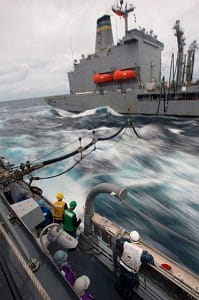Navy dreams of turning seawater into jet fuel

 Refueling a Navy vessel in the middle of the Pacific ocean isn’t like topping off the tank of your Hyundai: there are no filling stations right around the corner and nowhere to hike with a gas can if the needle hits “Empty”.
Refueling a Navy vessel in the middle of the Pacific ocean isn’t like topping off the tank of your Hyundai: there are no filling stations right around the corner and nowhere to hike with a gas can if the needle hits “Empty”.
That’s why scientists at the US Naval Research Laboratory (NRL) are looking for innovative ways to keep ships fueled up and ready to move while at sea. Their goal: to produce hydrogen gas and extract carbon dioxide from seawater, and combine those through a gas-to-liquids process that results in JP-5 jet fuel.
It might sound like a long shot, but the potential benefits are huge.
“The potential payoff is the ability to produce JP-5 fuel stock at sea reducing the logistics tail on fuel delivery with no environmental burden and increasing the Navy’s energy security and independence,” said Heather Willauer, a Naval research chemist.
The US Navy currently operates a fleet of 15 replenishment oilers around the globe. Last year, they delivered nearly 600 million gallons of fuel to Naval vessels at sea.
NRL researchers have already successfully tested electrochemical acidification cells that can generate carbon dioxide and hydrogen gas from seawater. They’ve also managed to convert those gases into hydrocarbons that could become the building blocks for producing jet fuel.
The NRL is currently working on optimizing and scaling up the processes tested so far. Early results suggest that producing jet fuel from seawater could cost anywhere from $3 to $6 per gallon.
“With such a process, the Navy could avoid the uncertainties inherent in procuring fuel from foreign sources and/or maintaining long supply lines,” Willauer said.




